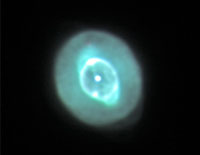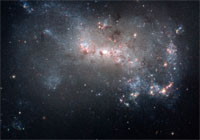This month we continue our tour of the Caldwell objects. The objects listed should be easily visible between the onset of darkness until at least 11 pm unless otherwise noted. Some objects will be low on the southern horizon. If you missed the March objects, most if not all can still be viewed. Info can be found here.
 Caldwell 59 (NGC 3242, the Ghost of Jupiter Nebula) - [10h 24.8m, -18°38'] - C59 is a diffuse planetary nebula that shows a bluish cast. It is clearly evident as a disk, although little detail will be evident except through photography as shown on the right (Photo courtesy of Adam Block, NOAO, AURA, NSF). Find the ghost about 2 degrees SSW of mu Hydrae.
Caldwell 59 (NGC 3242, the Ghost of Jupiter Nebula) - [10h 24.8m, -18°38'] - C59 is a diffuse planetary nebula that shows a bluish cast. It is clearly evident as a disk, although little detail will be evident except through photography as shown on the right (Photo courtesy of Adam Block, NOAO, AURA, NSF). Find the ghost about 2 degrees SSW of mu Hydrae.
Caldwell 40 (NGC 3626) - [11h 20.1m, +18°21'] - NGC 3626 shows a small but bright elongated core with what appears to be faint nebulosity surrounding it. No arms are visible either visually or in images. There is disagreement concerning the classification of the galaxy - some say S0 (hence, no arms), while others say Sb, but arms are obscured by a dust cloud. Interestingly, the dust seems to be moving opposite the stars, so perhaps a recent interaction has occured. It's an easy find, 2.5 degrees from Zosma in Leo in a direction that almost perfectly bisects the triangle that comprises Leo's posterior.
Caldwell 60/61 (NGC 4038/39) - [12h 01.9m, -18°53'] - These two targets comprise the antennae galaxies, a pair of interacting galaxies toward the west edge of Corvus. Through the eyepiece, the two galactic cores looked like a pair of fuzzy cotton balls separated by only a couple of arc-minutes. The antennae, two long arcs of stars that have resulted from the interaction, are not visible through the eyepiece, and are tough astrophoto targets. On a positive note, you get to check two objects off your list.
Caldwell 3 (NGC 4236) - [12h 16.7m, +69°28'] - Time to do a 180 with your scope and point North to Draco. C3 is a large galaxy with very low surface brightness. It's nearly edge-on, but so dim that the shape is difficult to make out. It's not a difficult region to find being just 1.5 degrees west from Kappa Draconis, but you'll need dark skies and possibly averted vision to pick this spiral galaxy out from the sky.
Caldwell 26 (NGC 4244, The Silver Needle Galaxy) - [12h 17.5m, +37°49'] - This edge-on galaxy is considerably easier to spot than C3 (above). To find it, start at Cor Caroli (in Canis Venetici), move toward Chara (the only other "bright" star in the constellation, then make a 90 degree turn to the right (away from the handle of the big dipper. C26 is about 5 degrees from Chara.
 Caldwell 21 (NGC 4449) - [12h 28.2m, +44°06'] - Don't move your observing chair, C21 is just a few degrees from C26 (above). To find it, start again at Cor Caroli, and move to Chara, but this time turn 45 degrees left and proceed for about 3 degrees. C21 is a irregular dwarf galaxy located about 12 million light-years from Earth. It's quite bright and appears a bit rectangular (see Hubble image at right).
Caldwell 21 (NGC 4449) - [12h 28.2m, +44°06'] - Don't move your observing chair, C21 is just a few degrees from C26 (above). To find it, start again at Cor Caroli, and move to Chara, but this time turn 45 degrees left and proceed for about 3 degrees. C21 is a irregular dwarf galaxy located about 12 million light-years from Earth. It's quite bright and appears a bit rectangular (see Hubble image at right).
Caldwell 36 (NGC 4559) - [12h 36.0m, +27°58'] - This bright spiral galaxy lies in Coma Berenices about 4/5ths of the way between Beta and Gamma Comae Berenices. C36 is estimated to be about 25 million light-years from Earth.
Caldwell 38 (NGC 4565) - [12h 36.3m, +25°59'] - Here's another chance to stay in your observing chair. NGC 4565 is a mere 2 degrees from NGC 4559. It's also the favorite galaxy of the venerable John Dobson. C38 is a large and photogenic edge-on galaxy in Coma Berenices. The galaxy boasts a large central bulge and a distinct dust lane visible even through the eyepiece. It's located 3.5 degrees SE of Gamma Comae Berenices

